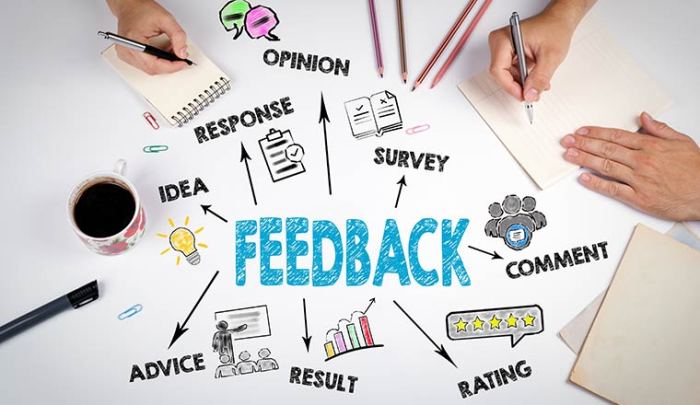Handling Customer Feedback kicks off a journey into the world of customer insights, where businesses thrive on understanding and implementing feedback for success. From positive vibes to constructive criticisms, get ready to dive deep into the art of customer feedback.
This topic delves into the crucial aspects of listening, receiving, analyzing, responding, and implementing changes based on customer feedback, providing a comprehensive guide for businesses looking to enhance their customer experience.
Understanding Customer Feedback

Customer feedback is essential for businesses to understand their customers’ needs and preferences. By listening to feedback, companies can make informed decisions to improve their products or services and enhance customer satisfaction.
Types of Customer Feedback
- Positive Feedback: This type of feedback highlights what customers like about a product or service. It can help businesses identify their strengths and continue providing excellent experiences.
- Negative Feedback: Negative feedback points out areas for improvement or issues that need to be addressed. While it may be challenging to hear, it provides valuable insights for businesses to make necessary changes.
- Constructive Feedback: Constructive feedback offers suggestions for improvement along with specific details on how to address issues. It helps businesses understand how to enhance their offerings effectively.
- Irrelevant Feedback: Irrelevant feedback does not contribute to the improvement of products or services. It is important for businesses to differentiate between relevant and irrelevant feedback to focus on actionable insights.
Benefits of Customer Feedback
Customer feedback can play a crucial role in product development and service enhancement. By analyzing feedback, companies can:
- Identify areas for improvement and make necessary changes.
- Enhance customer satisfaction by addressing issues and meeting customer needs.
- Gain a competitive edge by continuously improving products or services based on customer input.
- Build customer loyalty and trust by showing a commitment to listening and responding to feedback.
Receiving Customer Feedback: Handling Customer Feedback
Receiving customer feedback is crucial for businesses to understand the needs and preferences of their customers. It helps in improving products and services, building customer loyalty, and increasing overall satisfaction.
Methods for Collecting Customer Feedback
Collecting customer feedback can be done through various methods such as surveys, feedback forms, social media monitoring, and direct interactions. Surveys and feedback forms allow customers to provide detailed feedback in a structured manner. Social media monitoring helps in capturing real-time feedback and sentiment. Direct interactions, whether in person or over the phone, provide a personal touch and allow for more in-depth discussions.
Creating a Welcoming Environment for Customers to Share Feedback
Creating a welcoming environment for customers to share feedback is essential to encourage honest and constructive responses. Businesses should actively seek feedback, show appreciation for feedback received, and assure customers that their opinions are valued. Providing multiple channels for feedback and ensuring confidentiality can also make customers feel more comfortable sharing their thoughts.
Significance of Timeliness in Responding to Customer Feedback
Timeliness in responding to customer feedback is crucial to show customers that their opinions are taken seriously. Prompt responses can help in resolving issues quickly, preventing further dissatisfaction, and improving overall customer experience. Delayed responses may lead to frustration and a negative perception of the business.
Analyzing Customer Feedback
When it comes to analyzing customer feedback, organizing and categorizing the feedback is crucial to extract valuable insights that can drive business improvements. By systematically sorting through the feedback received, companies can identify trends, patterns, and areas for enhancement.
Organizing and Categorizing Customer Feedback
Organizing customer feedback involves grouping similar comments or suggestions together based on common themes or topics. This can be done manually by creating categories such as product quality, customer service, pricing, and more. Categorizing feedback helps in identifying recurring issues or positive aspects that customers are highlighting.
- Use spreadsheet software like Microsoft Excel or Google Sheets to create a structured format for inputting and organizing feedback.
- Utilize customer feedback management tools like SurveyMonkey, Qualtrics, or Medallia to automatically categorize and analyze feedback based on predefined criteria.
- Implement sentiment analysis tools like Lexalytics or MonkeyLearn to understand the emotional tone behind customer feedback, whether positive, negative, or neutral.
Identifying Trends and Patterns
Identifying trends or patterns in customer feedback involves looking for common themes or issues that are repeatedly mentioned by multiple customers. These trends can provide valuable insights into areas that require immediate attention or improvement within the business.
- Look for s or phrases that frequently appear in customer feedback, as these can indicate popular topics or concerns.
- Monitor changes in feedback over time to track improvements or declines in specific areas of the business.
- Utilize data visualization tools like Tableau or Power BI to create visual representations of feedback trends for easier interpretation.
Responding to Customer Feedback

When it comes to responding to customer feedback, it’s crucial to handle both positive and negative feedback with professionalism and care. Here are some best practices to keep in mind:
Responding to Positive Feedback
When receiving positive feedback from customers, it’s essential to show appreciation and gratitude. Here are some ways to respond to positive feedback:
- Express your thanks and appreciation for the kind words.
- Personalize your response by mentioning specific details from the feedback.
- Encourage the customer to continue sharing their thoughts and feedback in the future.
Addressing Negative Feedback
Dealing with negative feedback requires a delicate approach. Here’s how to address negative feedback professionally and constructively:
- Respond promptly and acknowledge the customer’s concerns.
- Show empathy and apologize for any inconvenience caused.
- Promise to investigate the issue and take necessary steps to prevent it from happening again.
- Offer a solution or compensation if applicable.
- Invite the customer to reach out directly to discuss the matter further.
Following Up with Customers
After addressing customer feedback, it’s important to follow up to ensure customer satisfaction. Here are some tips for following up with customers:
- Send a thank-you message for sharing feedback and let them know their input is valuable.
- Provide updates on the actions taken based on their feedback.
- Offer a discount or special promotion as a token of appreciation.
- Ask for feedback on the resolution process to show that their opinions matter.
Implementing Changes Based on Feedback
After receiving and analyzing customer feedback, the next crucial step is to implement changes based on the valuable insights provided. This involves prioritizing feedback, deciding which changes to make, communicating these changes effectively to customers, and ultimately improving the overall customer experience.
Process of Prioritizing Feedback and Deciding Which Changes to Implement
When prioritizing feedback, it is essential to consider the impact of the suggested changes on the customer experience. Some key factors to consider include the frequency of the feedback, the severity of the issue raised, and the alignment with the company’s goals and values. By prioritizing feedback based on these criteria, businesses can focus on making meaningful changes that will have a significant impact on customer satisfaction.
- Identify recurring themes or patterns in the feedback received.
- Assess the potential impact of addressing each feedback point on the overall customer experience.
- Consider the resources and time required to implement each change.
- Prioritize changes that align with the company’s mission and values.
Communicating Changes to Customers Effectively
Effective communication is key when implementing changes based on customer feedback. Customers appreciate transparency and openness, so it is important to clearly communicate the reasons behind the changes and how they will benefit the customer experience. Utilizing multiple communication channels such as email, social media, and website updates can help ensure that customers are informed about the changes.
- Provide a clear explanation of why the changes are being made.
- Highlight the benefits that the changes will bring to the customer.
- Offer channels for customers to provide feedback or ask questions about the changes.
- Update customers on the progress of the implementation of the changes.
Examples of Companies that Successfully Implemented Changes Based on Customer Feedback, Handling Customer Feedback
Several companies have demonstrated the importance of listening to customer feedback and implementing changes accordingly. For example, Starbucks introduced mobile ordering based on customer feedback to improve convenience and speed of service. Amazon constantly evolves its website based on customer feedback to enhance the shopping experience. These companies have shown that by actively listening to customers and implementing changes, they can improve customer satisfaction and loyalty.